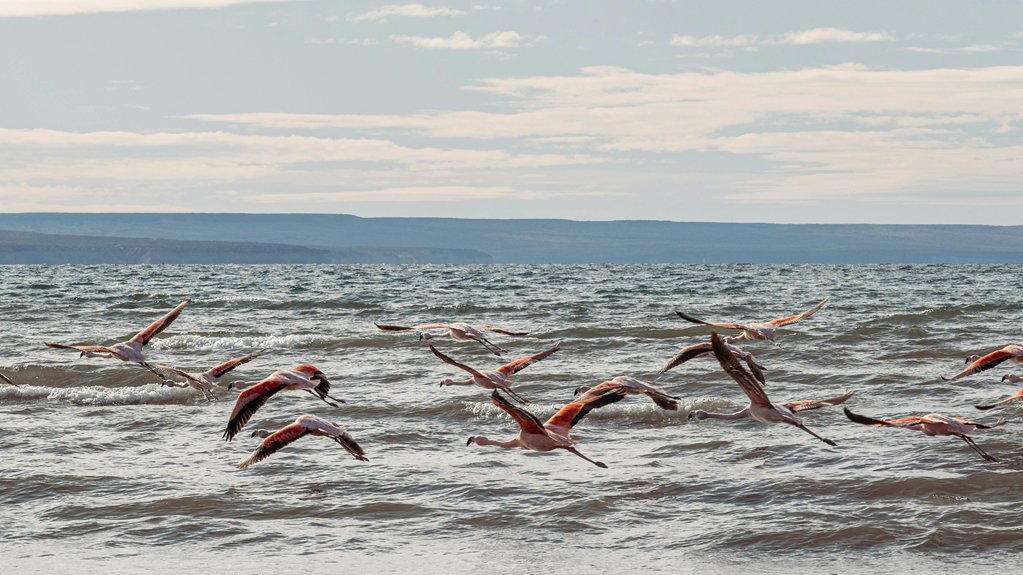You can spot three remarkable and rare birds at Larnaca Salt Lake. The Greater Flamingo migrates here in winter, feeding in shallow brackish waters that support up to 20,000 birds thanks to cyclical flooding creating rich feeding grounds. The striking Black-winged Stilt nests on reed islands, indicating the wetland’s stable water conditions. Over open fields, the acrobatic Lesser Kestrel hunts insects in summer, its declining numbers making sightings significant. These species reflect the lake’s ecological importance and seasonal complexity.
Principaux enseignements
- The Greater Flamingo is a spectacular rare bird at Larnaca Salt Lake, with up to 20,000 individuals feeding and wintering there annually.
- The Black-winged Stilt is a striking rare wader with black and white plumage and long red legs, breeding in small numbers on reed islands at the lake.
- The Lesser Kestrel, a small falcon with a grey head and tail, is a summer migrant hunting insects and small prey above the lake’s fields.
- Larnaca Salt Lake’s wetlands provide critical habitat and feeding grounds, making it an important stopover for these rare migratory and breeding birds.
- These birds serve as ecological indicators of the lake’s health and biodiversity, highlighting the significance of preserving this Mediterranean wetland.
Greater Flamingo
Although the Larnaca Salt Lake remains dry during summer, it fills with water in winter, creating a suitable habitat for the Greater Flamingo (Phoenicopterus roseus) to migrate and temporarily reside. This cyclical inundation transforms the salt flats into a rich feeding ground where up to 20,000 flamingos may gather, making it one of the most significant concentrations of this rare bird species at Larnaca Salt Lake. You can observe these striking pink birds feeding in shallow brackish waters, filtering algae and small invertebrates with their specialized bills. Their presence is not only a spectacular visual display but also an ecological indicator of the lake’s health and seasonal dynamics. The Greater Flamingo’s winter residency here highlights the lake’s importance as a critical migratory stopover in the Mediterranean region, supporting avian biodiversity amid fluctuating environmental conditions.
Black-winged Stilt
While you explore the rich birdlife at Larnaca Salt Lake, you will notice the elegant Black-winged Stilt (Himantopus himantopus) frequenting its shallow waters. This species stands out with its striking black and white plumage contrasted by long, slender red legs. You’ll often hear its sharp, distinctive call piercing the quiet of the wetland. The Black-winged Stilt primarily inhabits wetland areas, nesting close to water or on small islets surrounded by shallow water. It’s highly sensitive to abrupt water level changes, which can affect its breeding success. At Larnaca Salt Lake, you might observe a limited number of breeding pairs, typically between 5 to 10, favoring reed islands and similar habitats. Their diet consists of invertebrates, small fish, and aquatic seeds, which they skillfully forage in the shallow waters. These birds serve as crucial indicators of wetland ecosystem health due to their reliance on stable water conditions.
Lesser Kestrel
Flying above the open fields that fringe the Larnaca Salt Lake, the Lesser Kestrel (Falco naumanni) catches your eye with its buoyant flight and swift, agile maneuvers as it scans for prey. This small falcon, measuring 27–33 cm in length with a 63–72 cm wingspan, is distinguishable from the similar Common Kestrel by its proportionally shorter wings and tail, and the male’s grey head and tail without dark spotting or black malar stripe. Its whitish-horn colored talons, visible only at close range, further aid identification.
You’ll notice the Lesser Kestrel often hunts insects, small birds, reptiles, and rodents on the ground, using its acrobatic flight to surprise prey. It breeds colonially on buildings or cliffs, laying 3 to 6 eggs without constructing a nest itself. This species is a summer migrant in the region, with a declining population in Europe, making sightings at Larnaca Salt Lake all the more significant.
Questions fréquemment posées
When Is the Best Time to Visit Larnaca Salt Lake for Birdwatching?
You’ll find the best birdwatching at Larnaca Salt Lake during spring migration from late March to early May and autumn migration from September to November, when many migratory species pass through. Early mornings and late afternoons maximize bird activity and visibility, especially in warmer months. For flamingos, visit between late November and mid-March for the highest chance to spot large flocks, particularly near the mosque area and airport side. Avoid peak summer heat and tourist crowds for ideal experience.
Are Pets Allowed at Larnaca Salt Lake Birdwatching Sites?
Like a delicate ecosystem balanced on a knife’s edge, Larnaca Salt Lake maintains strict rules to protect its avian inhabitants. Pets are generally not allowed at the main birdwatching sites around the salt lake to avoid disturbing rare and sensitive bird species. Instead, you can bring your dog to designated areas like Doggy Beach in Larnaca, where pets can romp freely without impacting bird habitats or wildlife observation. This policy guarantees favorable conditions for scientific observation and conservation.
What Equipment Is Recommended for Birdwatching at Larnaca Salt Lake?
For birdwatching at Larnaca Salt Lake, you should use high-quality binoculars to observe flamingos and other species at a respectful distance without disturbance. A spotting scope can enhance distant views. Dress in layers to handle the variable, often windy conditions around the exposed salt flats. Bring sun protection, water, and a field notebook for recording observations. Stick to designated trails and hides to minimize impact on wildlife and habitat.
How Accessible Are the Trails and Hides Around Larnaca Salt Lake?
You can hit the ground running on Larnaca Salt Lake’s trails-they’re well-marked and accessible to all experience levels, with flat terrain and gentle slopes. Observation hides and designated paths keep you close to nature while safeguarding the fragile environment and nesting zones. Rest areas invite pauses, and signage keeps you informed, so you explore confidently and responsibly.
Are There Guided Tours Available for Birdwatching at Larnaca Salt Lake?
You can join guided birdwatching tours at Larnaca Salt Lake, which include expert guides who help identify and observe bird species like flamingos and migratory waterbirds. These tours often start early morning and last a few hours, covering accessible trails and hides around the lake. They provide detailed insights into the birds’ behaviors and habitat, enhancing your observational experience during migration seasons between spring and autumn.
Conclusion
At Larnaca Salt Lake, the elegant Greater Flamingo’s vivid pink contrasts sharply with the slender, stark Black-winged Stilt’s monochrome silhouette, while the Lesser Kestrel’s swift, agile flight brings a falconry grace to the scene. This juxtaposition of size, color, and behavior reveals a complex ecosystem where endangered and migratory birds rely on the lake’s unique habitat for survival. Your keen observation here underscores the delicate balance sustaining these rare species in this wetland sanctuary.

Voici Natalie, qui vit à Chypre depuis dix ans. Elle adore explorer la belle nature de l'île, comme les forêts tranquilles et les plages vierges. Natalie a beaucoup d'expériences intéressantes à partager. Rejoignez-la lorsqu'elle vous parlera de ses aventures à Chypre.

